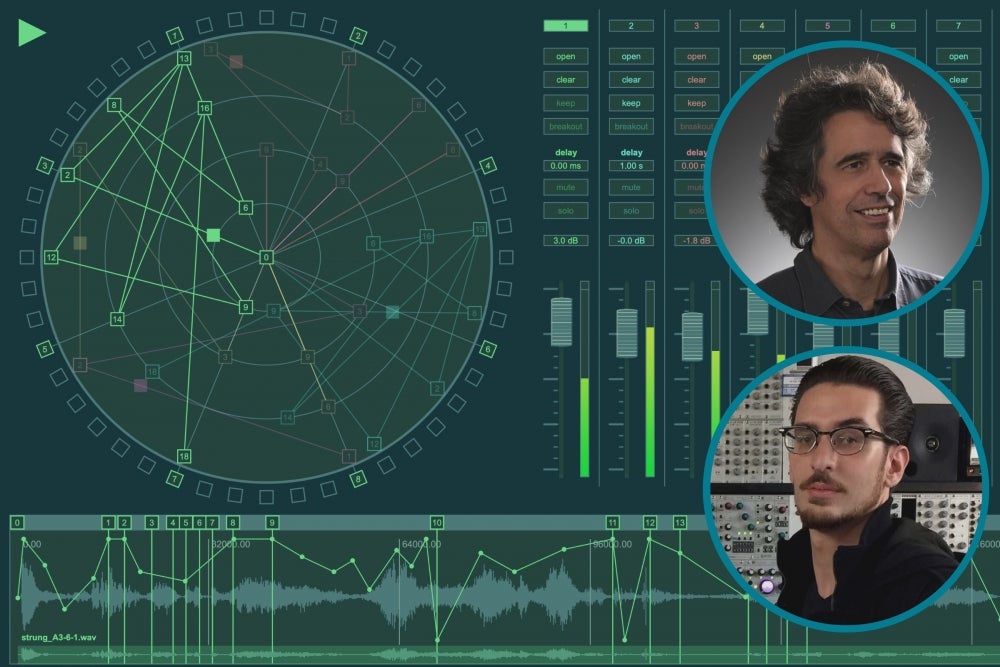
Space Control
Much of the allure to see movies on the big screen comes from how theaters can create an environment where sound surrounds the audience. Displaced sound, which helps to create the immersive cinematic experience, has also been a distinguishing feature of electronic music — particularly acousmatic electronic music — growing in popularity since its emergence in the 1950s. Technology to create spatial compositions, however, has not kept pace with the needs of composers who now write single compositions for dozens of speakers. (A handful of high-end concert halls each have over 100 speakers).
With no universal software solution in sight, composer João Pedro Oliveira, Corwin Chair of Composition in UC Santa Barbara’s Department of Music, set out to create an application for composers to specify how sounds move in space. He enlisted software developer and student Raphael Radna, who is simultaneously completing his doctoral studies in composition and a master’s degree in media arts and technology. Together they built Space Control, an app which UCSB’s Center for Research in Electronic Art Technology (CREATE) recently released to the public.
A multitrack workstation, Space Control is a user-friendly tool for electroacoustic music composers to design and mix spatial gestures. Creating a spatialization app with a minimal learning curve was a top priority, noted Oliveira, who wanted to “simplify the facets of spatial composition, allowing users to focus only on the creative elements.”
With that goal, Radna set out to develop an “intuitive program,” he said, “something that allows people to compose acousmatic music without training in computer programming or the science of spatial audio.”
Considering how popular and cross-generational the musical form has become, usability for a spatialization app is paramount. The tradition of electronic music has long embraced the expressive potential of sound movement in space, which can now be understood as a parameter of composition, Radna added, much like the more common ones: pitch, rhythm, timbre and so on.
Acousmatic music is listened to as a concert experience but without performers where sound is projected over speakers. “It creates a situation in which we hear sound but don’t see how it’s produced; so, the use of space is of particular interest to this genre,” Radna said.
Space Control makes it easy to define trajectories in space for multiple sound files, giving each individual sound in a composition its own location or path and defining its movement in space and time. The app allows outputs for up to 24 loudspeakers and supports circular arrangements of speakers, which are commonly used in electronic music concerts and festivals around the world.
“Sometimes if you sit in a hall and you have an electronic sound that goes around you in a circle, that causes a certain tension — a feeling of energy that is caused by the movement of the sound in space,” Oliveira said. “Energy levels change, and space can make them more prominent or more active. Having the listener feel that the sound is all around them — displacing itself — it’s a very interesting aspect.”
For composers working with sound spatialization, creating a composition that comes together from displaced sounds can be a test of trial and error. Oliveira and Radna’s app helps alleviate some of that empirical labor by providing a visualization of the space where sounds can be displaced. The app then plays back a user’s spatial mix in real time so that they can make changes as they go. When compositions are complete, the user can export individual audio files for each speaker that can be played by any comparable sound system in the world.
“When we work with spatial movements of sounds, many times we are confronted with the problem, how do we displace it?” Oliveira said. “Which direction will it go? What kind of path will it take in space? While I’m working on new compositions using electronic sounds, many times as I do the sounds, I’m thinking what is the energy that these sounds will suggest as space movements.”
Beyond composers, Oliveira and Radna imagine other users benefitting from the app as well, including sound designers for theater or film, sound artists and art practitioners who create multi-channel works for installation — and potentially psychoacoustic researchers.
Space Control was developed over a period of two years and released in June. It is built in the visual programming environment Max/MSP, with custom interface elements coded in Javascript, and core audio functionality carried out by external objects written in C++. Radna and Oliveira have presented Space Control at the International Computer Music Conference, the Visiones Sonoras International Festival of Music and New Technologies, and the SEAMUS National Conference. The project was supported by a faculty research grant from the UC Santa Barbara Academic Senate.
Space Control runs on Apple and Windows computers, and is available on GitHub as a free download.



